Political campaign
A political campaign is an organized effort which seeks to influence the decision making progress within a specific group. In democracies, political campaigns often refer to electoral campaigns, by which representatives are chosen or referendums are decided. In modern politics, the most high-profile political campaigns are focused on general elections and candidates for head of state or head of government, often a president or prime minister.
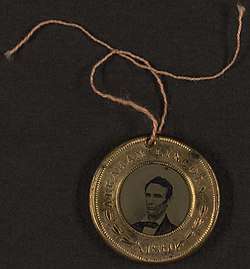
| Part of the Politics series |
| Political campaigning |
|---|
| Key people |
| Politics portal |
Campaign message
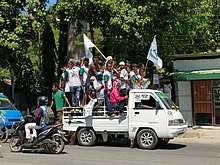
The message of the campaign contains the ideas that the candidate wants to share with the voters. It is to get those who agree with their ideas to support them when running for a political position. The message often consists of several talking points about policy issues. The points summarize the main ideas of the campaign and are repeated frequently in order to create a lasting impression with the voters. In many elections, the opposition party will try to get the candidate "off message" by bringing up policy or personal questions that are not related to the talking points. Most campaigns prefer to keep the message broad in order to attract the most potential voters. A message that is too narrow can alienate voters or slow the candidate down with explaining details. For example, in the 2008 American presidential election John McCain originally used a message that focused on his patriotism and political experience: "Country First"; later the message was changed to shift attention to his role as "The Original Maverick" within the political establishment. Barack Obama ran on a consistent, simple message of "change" throughout his campaign.
Campaign finance
Fundraising techniques include having the candidate call or meet with large donors, sending direct mail pleas to small donors, and courting interest groups who could end up spending millions on the race if it is significant to their interests.
Organization
In a modern political campaign, the campaign organization (or "machine") will have a coherent structure of personnel in the same manner as any business of similar size.
Campaign manager
Successful campaigns usually require a campaign manager to coordinate the campaign's operations. Apart from a candidate, they are often a campaign's most visible leader. Modern campaign managers may be concerned with executing strategy rather than setting it - particularly if the senior strategists are typically outside political consultants such as primarily pollsters and media consultants.
Political consultants
Political consultants advise campaigns on virtually all of their activities, from research to field strategy. Consultants conduct candidate research, voter research, and opposition research for their clients.
Activists
Activists are the "foot soldiers" loyal to the cause, the true believers who will carry the run by volunteer activists. Such volunteers and interns may take part in activities such as canvassing door-to-door and making phone calls on behalf of the campaigns.
Techniques
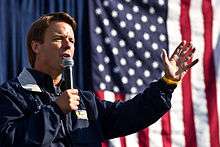
A campaign team (which may be as small as one inspired individual, or a heavily resourced group of professionals) must consider how to communicate the message of the campaign, recruit volunteers, and raise money. Campaign advertising draws on techniques from commercial advertising and propaganda, also entertainment and public relations, a mixture dubbed politainment. The avenues available to political campaigns when distributing their messages is limited by the law, available resources, and the imagination of the campaigns' participants. These techniques are often combined into a formal strategy known as the campaign plan. The plan takes account of a campaign's goal, message, target audience, and resources available. The campaign will typically seek to identify supporters at the same time as getting its message across. The modern, open campaign method was pioneered by Aaron Burr during the American presidential election of 1800.[1][2][3]
Campaign communication
Election campaign communication refers to party-controlled communication, e.g. campaign advertising, and party-uncontrolled communication, e.g. media coverage of elections.
Campaign advertising
Campaign advertising is the use of paid media (newspapers, radio, television, etc.) to influence the decisions made for and by groups. These ads are designed by political consultants and the campaign's staff.
Media management
The public media (in US parlance "free media" or "earned media") may run the story that someone is trying to get elected or to do something about certain aspects regarding their specific country.
Demonstrations
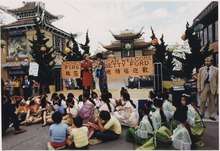
Modern technology and the internet
The internet is now a core element of modern political campaigns. Communication technologies such as e-mail, websites, and podcasts for various forms of activism enable faster communications by citizen movements and deliver a message to a large audience. These Internet technologies are used for cause-related fundraising, lobbying, volunteering, community building, and organizing. Individual political candidates are also using the internet to promote their election campaign. In a study of Norwegian election campaigns, politicians reported they used social media for marketing and for dialogue with voters. Facebook was the primary platform for marketing and Twitter was used for more continuous dialogue.[4]
Signifying the importance of internet political campaigning, Barack Obama's presidential campaign relied heavily on social media, Search Engine Optimisation (SEO) and new media channels to engage voters, recruit campaign volunteers, and raise campaign funds. The campaign brought the spotlight on the importance of using internet in new-age political campaigning by utilizing various forms of social media and new media (including Facebook, YouTube and a custom generated social engine) to reach new target populations. The campaign's social website, my.BarackObama.com, utilized a low cost and efficient method of mobilizing voters and increasing participation among various voter populations.[5] This new media was incredibly successful at reaching the younger population while helping all populations organize and promote action.
Now Online Election campaign has got a new dimension, the campaign information can be shared as in Rich Info format through campaign landing pages, integrating Google's rich snippets, structured data,[6] Social media open graphs, and husting support file formats for YouTube like .sbv (SubRip), .srt (subtitle resource track), .vtt (Video text trace), high proficiency and effective algorithmic integration will be the core factor in the frame-work. This technology integration helps campaign information to reach a wide audience in split seconds. This has successfully been tested and implemented in 2015 Aruvikkara Election Kerala.[7]* Marcus Giavanni, social media consultant and blockchain developer and second place opponent in the 2015 election, was first to file for the 2019 election. Marcus Giavanni Uses Advanced Algorithms, Artificial Intelligence, and Voice Indexing Predictions to box in campaigns.[8]
Husting
A husting, or the hustings, was originally a physical platform from which representatives presented their views or cast votes before a parliamentary or other election body. By metonymy, the term may now refer to any event, such as debates or speeches, during an election campaign where one or more of the representative candidates are present.
Other techniques
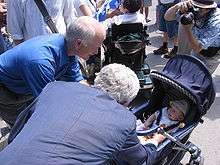
- Writing directly to members of the public (either via a professional marketing firm or, particularly on a small scale, by volunteers)
- By distributing leaflets or selling newspapers
- Through websites, online communities, and solicited or unsolicited bulk email[9]
- Through a new technique known as microtargeting that helps identify and target small demographic slices of voters
- Through a whistlestop tour - a series of brief appearances in several small towns
- Hampering the ability of political competitors to campaign, by such techniques as counter-rallies, picketing of rival parties’ meetings, or overwhelming rival candidates' offices with mischievous phone calls (most political parties in representative democracies publicly distance themselves from such disruptive and morale-affecting tactics, with the exception of those parties self-identifying as activist
- Organizing political house parties
- Using endorsements of other celebrated party members to boost support (see coattail effect)
- Using a campaign surrogate - a celebrity or person of influence, campaigning on a candidate’s behalf.
- Remaining close to or at home to make speeches to supporters who come to visit as part of a front porch campaign
- Vote-by-mail, previously known as "absentee ballots" have grown significantly in importance as an election tool. Campaigns in most states must have a strategy in place to impact early voting
- Sale of official campaign merchandise (colloquially known as Swag, in reference to the baiting technique) as a way of commuting a competitor's popularity into campaign donations, volunteer recruitment, and free advertising[10]
Campaign types
Informational campaign
An informational campaign is a political campaign designed to raise public awareness and support for the positions of a candidate (or her/his party).[11] It is more intense than a paper campaign, which consists of little more than filing the necessary papers to get on the ballot, but is less intense than a competitive campaign, which aims to actually win election to the office. An informational campaign typically focuses on low-cost outreach such as news releases, getting interviewed in the paper, making a brochure for door to door distribution, organizing poll workers, etc.[12]
Paper campaign
A paper campaign is a political campaign in which the candidate only files the necessary paperwork to appear on the ballot.[13][14] The purpose of such a token effort may be simply to increase name awareness of a minor political party or to give voters of a certain ideology an opportunity to vote accordingly. It can be a cost-effective means of attracting media coverage. An informational campaign, by contrast, may involve news releases, newspaper interviews, door-to-door campaigning, and organizing polls. As the level of seriousness rises, the marginal cost of reaching more people rises accordingly, due to the high cost of TV commercials, paid staff, etc. which are used by competitive campaigns.[15]
Effects
A forthcoming study in the American Political Science Review found that campaigns have "an average effect of zero in general elections".[16][17] The study found two instances where campaigning was effective: "First, when candidates take unusually unpopular positions and campaigns invest unusually heavily in identifying persuadable voters. Second, when campaigns contact voters long before election day and measure effects immediately — although this early persuasion decays."[16][17]
Presidential campaigns
A large body of political science research emphasizes how "fundamentals" - the state of the economy, whether the country is at war, how long the president's party has held the office, and which candidate is more ideologically moderate - predict presidential election outcomes.[18][19][20][21][22] However, campaigns may be necessary to enlighten otherwise uninformed voters about the fundamentals, which thus become increasingly predictive of preferences as the campaign progresses.[18][23][24][25] Research suggests that "the 2012 presidential campaigns increased turnout in highly targeted states by 7–8 percentage points, on average, indicating that modern campaigns can significantly alter the size and composition of the voting population.".[26]
National conventions
A consensus in the political science literature holds that national conventions usually have a measurable effect on presidential elections that is relatively resistant to decay.[23][24][25]
Presidential and vice-presidential debates
Research is mixed on the precise impact of debates.[23][25][27] Rather than encourage viewers to update their political views in accordance with the most persuasive arguments, viewers instead update their views to merely reflect what their favored candidate is saying.[28]
Presidential primaries
The fundamentals matter less in the outcome of presidential primaries. One prominent theory holds that the outcome of presidential primaries is largely determined by the preferences of party elites.[29] Presidential primaries are therefore less predictive, as all kinds of events may impact elites' perception of the viability of candidates. Gaffes, debates and media narratives play a greater role in primaries than in presidential elections.[19][30]
Strategies
Traditional ground campaigning and voter contacts remain the most effective strategies.[26][31] Some research suggests that knocking on doors can increase turnout by as much as 10%[32] and phone calls by as much as 4%.[33] One study suggests that lawn signs increase vote share by 1.7 percentage points.[34] A review of more than 200 get-out-the-vote experiments finds that the most effective tactics are personal: Door-to-door canvassing increases turnout by an average of about 2.5 percentage points; volunteer phone calls raise it by about 1.9 points, compared to 1.0 points for calls from commercial phone banks; automated phone messages are ineffective.[35][36] Each field office that the Obama campaign opened in 2012 gave him approximately a 0.3% greater vote share.[37] The Obama 2008 campaign's use of field most offices has been credited as crucial in winning Indiana and North Carolina.[38] According to one study, the cost per vote by having a field office is $49.40.[38] Using out-of-state volunteers for canvassing is less effective in increasing turnout than using local and trained volunteers.[39][40]
Political science research generally finds negative advertisement (which has increased over time)[41] to be ineffective both at reducing the support and turnout for the opponent.[42] According to political scientists Stephen Ansolabehere and Shanto Iyengar, negative ads do succeed at driving down overall turnout though.[43] They also find that "negative ads work better for Republicans than for Democrats, and better for men than for women; unfortunately, negative ads also work better in general than positive ones."[43] Challengers who spend more time campaigning get a higher vote share against incumbents in state house elections.[44] According to political scientist Lynn Vavreck, "the evidence suggests that campaign ads have small effects that decay rapidly — very rapidly — but just enough of the impact accumulates to make running more advertising than your opponent seem a necessity."[45] A 2019 study of online political advertising conducted by a party in the 2016 Berlin state election campaign found that the online-ad campaign "increased the party's vote share by 0.7 percentage points" and that factual ads were more effective than emotional ads.[46]
According to political scientists Donald Green and Alan Gerber, it costs $31 to produce a vote going door to door, $91-$137 to produce a vote by sending out direct mailers, $47 per vote from leafletting, $58-$125 per vote from commercial phone banking, and $20-$35 per vote from voluntary phone banking.[47] A 2018 study in the American Economic Review found that door-to-door canvassing on behalf of the Francois Hollande campaign in the 2012 French presidential election "did not affect turnout, but increased Hollande's vote share in the first round and accounted for one fourth of his victory margin in the second. Visits' impact persisted in later elections, suggesting a lasting persuasion effect."[48] According to a 2018 study, repeated get-out-the-vote phone calls had diminishing effects but each additional phone call increased the probability to vote by 0.6-1.0 percentage points.[49] Another 2018 study found that "party leaflets boost turnout by 4.3 percentage points while canvassing has a small additional effect (0.6 percentage points)" in a United Kingdom election.[50]
A 2016 study found that visits by candidate visits to states have modest effects: "visits are most effective in influencing press coverage at the national level and within battleground states. Visits’ effects on voters themselves, however, are much more modest than consultants often claim, and visits appear to have no effects outside the market that hosts a visit."[51] The authors of the study argue that it would be more effective for campaigns to go to the pockets of the country where wealthy donors are (for fundraising) and hold rallies in the populous states both to attract national press and raise funds.[51] A 2005 study found that campaign visits had no statistically significant effect, after controlling for other factors, on voter turnout in the 1992, 1996, and 2000 elections.[52] On the other hand, a 2017 paper of the 1948 presidential election provides "strong evidence that candidate visits can influence electoral returns".[53] Other research also provides evidence that campaign visits increase vote share.[54]
According to a 2020 study, campaign spending on messaging to voters affects voter support for candidates.[55]
History
Political campaigns have existed as long as there have been informed citizens to campaign amongst. Democratic societies have regular election campaigns, but political campaigning can occur on particular issues even in non-democracies so long as freedom of expression is allowed. Often mass campaigns are started by the less privileged or anti-establishment viewpoints (as against more powerful interests whose first resort is lobbying). The phenomenon of political campaigns are tightly tied to lobby groups and political parties.
The first modern campaign is often described as William Ewart Gladstone's Midlothian campaign in 1878-80, although there may be earlier recognizably modern examples from the 19th century. The 1896 William McKinley presidential campaign laid the groundwork for modern campaigns.[56][57]
In the 1790-1820s, the Federalist Party and the Democratic-Republican Party battled it out in the so-called "First Party System". American election campaigns in the 19th century created the first mass-base political parties and invented many of the techniques of mass campaigning.
See also
| Wikimedia Commons has media related to Political campaigns. |
- Techniques and traditions
- Canvassing
- Election litter
- Election promise
- Husting
- Lawn sign
- Microtargeting
- Permanent campaign
- Political campaign staff
- Research strategies of election campaign communication research
- Robocalls & Personalized audio messaging
- Votebank
- Assumed Incumbency
- General topics
- Activism
- Civics
- Lobbying
- Media manipulation
- Minimal effects hypothesis
- Portal:Politics
References
- "The Election of 1800". Lehrman Institute.
- Unger, Harlow Giles (2014). John Marshall: the Chief Justice Who Saved the Nation. Hachette Books. ISBN 978-0306822216.
- Wheelan, Joseph (2006). Jefferson's Vendetta: the Pursuit of Aaron Burr and the Judiciary. PublicAffairs. ISBN 0786716894.
- Enli, Sara Gunn; Skogerbø, Eli (2013). "Personalized campaigns in party-centred politics". Information, Communication & Society. 16 (5): 757. doi:10.1080/1369118x.2013.782330.
- Lyons, Daniel (2008-11-22). "President 2.0". Newsweek. Retrieved 2010-05-11.
Obama harnessed the grass-roots power of the Web to get elected. How will he use that power now?
- "Introduction to Structured Data - Search".
- "Online Election Campaign plans". 9 March 2016.
- "Several candidates have filed to run for Denver mayor in 2019. Here's what they say". Denver Post. May 29, 2018. Retrieved October 2, 2018.
- "Campaign TV". Archived from the original on 2017-02-02. Retrieved 2020-05-08.
- Diane Tucker, Dawn Teo (3 November 2008). "Off The Bus: Obama Campaign Rewrites Fundraising Rules by Selling Merchandise". Huffington Post. Retrieved 20 May 2009.
- "Publications - Social Research - Swinburne University - Melbourne" (PDF).
- "Changing Focus/Priorities". Lppa.org. Archived from the original on July 25, 2008. Retrieved 2008-11-08.
- "10 Questions With Libertarian Party of Nevada Chairman Jim Duensing, Pt. 2".
- "Media" (PDF). Archived from the original (PDF) on 2017-10-19. Retrieved 2015-04-02.
- Changing Focus/Priorities Archived July 25, 2008, at the Wayback Machine
- Kalla, Joshua; Broockman, David E. (2017-09-25). "The Minimal Persuasive Effects of Campaign Contact in General Elections: Evidence from 49 Field Experiments". Rochester, NY. SSRN 3042867. Cite journal requires
|journal=(help) - "A massive new study reviews the evidence on whether campaigning works. The answer's bleak". Vox. Retrieved 2017-10-04.
- Gelman, Andrew; King, Gary (2008-01-17). "Why are American Presidential Election Campaign Polls so Variable When Votes are so Predictable?". Rochester, NY: Social Science Research Network. SSRN 1084120. Cite journal requires
|journal=(help) - Noel, Hans (2010). "Ten Things Political Scientists Know that You Don't". The Forum. 8 (3). doi:10.2202/1540-8884.1393.
- Bartels, Larry M.; Zaller, John (2001-03-01). "Presidential Vote Models: A Recount". PS: Political Science & Politics. null (1): 9–20. CiteSeerX 10.1.1.471.3300. doi:10.1017/S1049096501000026. ISSN 1537-5935.
- Jr, Douglas A. Hibbs (2000-07-01). "Bread and Peace Voting in U.S. Presidential Elections". Public Choice. 104 (1–2): 149–180. doi:10.1023/A:1005292312412. ISSN 0048-5829.
- "Vavreck, L.: The Message Matters: The Economy and Presidential Campaigns. (eBook and Paperback)". press.princeton.edu. Retrieved 2016-04-23.
- "The Timeline of Presidential Elections". University of Chicago Press. Retrieved 2016-04-23.
- "The Obama Victory". global.oup.com. Retrieved 2016-04-23.
- "Sides, J. and Vavreck, L.: The Gamble: Choice and Chance in the 2012 Presidential Election. (Updated Edition) (eBook and Paperback)". press.princeton.edu. Retrieved 2016-04-23.
- Enos, Ryan D.; Fowler, Anthony (2016-05-01). "Aggregate Effects of Large-Scale Campaigns on Voter Turnout". Political Science Research and Methods. FirstView (4): 733–751. doi:10.1017/psrm.2016.21. ISSN 2049-8489.
- Shaw, Daron R. (1999-05-01). "A Study of Presidential Campaign Event Effects from 1952 to 1992". The Journal of Politics. 61 (2): 387–422. doi:10.2307/2647509. ISSN 1468-2508. JSTOR 2647509.
- Abramowitz, Alan I. (1978-01-01). "The Impact of a Presidential Debate on Voter Rationality". American Journal of Political Science. 22 (3): 680–690. doi:10.2307/2110467. JSTOR 2110467.
- "The Party Decides". University of Chicago Press. Retrieved 2016-04-23.
- "Why News Coverage of the Debate May Matter More than the Debate - The Monkey Cage". The Monkey Cage. Retrieved 2016-04-23.
- Weinschenk, Aaron C. (2015-09-01). "Polls and Elections: Campaign Field Offices and Voter Mobilization in 2012". Presidential Studies Quarterly. 45 (3): 573–580. doi:10.1111/psq.12213. ISSN 1741-5705.
- Gerber, Alan S.; Green, Donald P. (2000-01-01). "The Effects of Canvassing, Telephone Calls, and Direct Mail on Voter Turnout: A Field Experiment". The American Political Science Review. 94 (3): 653–663. doi:10.2307/2585837. JSTOR 2585837.
- Nickerson, David W. (2007-04-01). "Quality Is Job One: Professional and Volunteer Voter Mobilization Calls". American Journal of Political Science. 51 (2): 269–282. doi:10.1111/j.1540-5907.2007.00250.x. ISSN 1540-5907.
- Green, Donald P.; Krasno, Jonathan S.; Coppock, Alexander; Farrer, Benjamin D.; Lenoir, Brandon; Zingher, Joshua N. (2016-03-01). "The effects of lawn signs on vote outcomes: Results from four randomized field experiments". Electoral Studies. 41: 143–150. doi:10.1016/j.electstud.2015.12.002.
- Green, Donald P.; McGrath, Mary C.; Aronow, Peter M. (2013-02-01). "Field Experiments and the Study of Voter Turnout". Journal of Elections, Public Opinion and Parties. 23 (1): 27–48. doi:10.1080/17457289.2012.728223. ISSN 1745-7289.
- Jacobson, Gary C. (2015-01-01). "How Do Campaigns Matter?". Annual Review of Political Science. 18 (1): 31–47. doi:10.1146/annurev-polisci-072012-113556.
- Masket, Seth; Sides, John; Vavreck, Lynn (2015-07-27). "The Ground Game in the 2012 Presidential Election". Political Communication. 0 (2): 169–187. doi:10.1080/10584609.2015.1029657. ISSN 1058-4609.
- Darr, Joshua P.; Levendusky, Matthew S. (2014-05-01). "Relying on the Ground Game The Placement and Effect of Campaign Field Offices". American Politics Research. 42 (3): 529–548. doi:10.1177/1532673X13500520. ISSN 1532-673X.
- Sinclair, Betsy; McConnell, Margaret; Michelson, Melissa R. (2013-01-01). "Local Canvassing: The Efficacy of Grassroots Voter Mobilization". Political Communication. 30 (1): 42–57. doi:10.1080/10584609.2012.737413. ISSN 1058-4609.
- Middleton, Joel A.; Green, Donald P. (March 2008). "Do community-based voter mobilization campaigns work even in battleground states? Evaluating the effectiveness of MoveOn's 2004 outreach campaign". Quarterly Journal of Political Science. 3 (1): 63–82. doi:10.1561/100.00007019.CS1 maint: ref=harv (link)
- Dowling, Conor M.; Krupnikov, Yanna (2016-11-22). "The Effects of Negative Advertising". Oxford Research Encyclopedia of Politics. doi:10.1093/acrefore/9780190228637.013.51. ISBN 9780190228637.
- Lau, Richard R.; Sigelman, Lee; Rovner, Ivy Brown (2007-11-01). "The Effects of Negative Political Campaigns: A Meta-Analytic Reassessment". Journal of Politics. 69 (4): 1176–1209. doi:10.1111/j.1468-2508.2007.00618.x. ISSN 1468-2508.
- Ansolabehere, Stephen; Iyengar, Shanto (1997-08-01). Going Negative. Free Press. ISBN 9780684837116.
- Miller, Michael G. (2016-05-01). "The Power of an Hour: Effects of Candidate Time Expenditure in State Legislative Elections". Legislative Studies Quarterly. 41 (2): 327–359. doi:10.1111/lsq.12116. ISSN 1939-9162.
- Vavreck, Lynn (2016-06-20). "Yes, Political Ads Are Still Important, Even for Donald Trump". The New York Times. ISSN 0362-4331. Retrieved 2016-06-20.
- Hager, Anselm (2019). "Do Online Ads Influence Vote Choice?". Political Communication. 36 (3): 376–393. doi:10.1080/10584609.2018.1548529.
- "Every vote matters. What's the best way to get them?". Public Radio International. Retrieved 2016-06-10.
- Vincent, Pons (2018). "Will a Five-Minute Discussion Change Your Mind? Countrywide Experiment on Voter Choice in France". American Economic Review. 0 (6): 1322–1363. doi:10.1257/aer.20160524. ISSN 0002-8282.
- "Repeated treatment in a GOTV field experiment: Distinguishing between intensive and extensive margin effects". Missing or empty
|url=(help) - Townsley, Joshua (n.d.). "Is it worth door-knocking? Evidence from a United Kingdom-based Get Out The Vote (GOTV) field experiment on the effect of party leaflets and canvass visits on voter turnout". Political Science Research and Methods: 1–15. doi:10.1017/psrm.2018.39. ISSN 2049-8470.
- Wood, Thomas (2016-09-01). "What The Heck Are We Doing in Ottumwa, Anyway? Presidential Candidate Visits and Their Political Consequence". The Annals of the American Academy of Political and Social Science. 667 (1): 110–125. doi:10.1177/0002716216661488. ISSN 0002-7162.
- Holbrook, Thomas M.; McClurg, Scott D. (2005-10-01). "The Mobilization of Core Supporters: Campaigns, Turnout, and Electoral Composition in United States Presidential Elections". American Journal of Political Science. 49 (4): 689–703. doi:10.1111/j.1540-5907.2005.00149.x. ISSN 1540-5907.
- Heersink, Boris; Peterson, Brenton D. (2017). "Truman defeats Dewey: The effect of campaign visits on election outcomes". Electoral Studies. 49: 49–64. doi:10.1016/j.electstud.2017.07.007.
- Bednar, Steven (2017-07-28). "Campaigning and election outcomes in a presidential primary election". Applied Economics Letters. 0 (10): 713–717. doi:10.1080/13504851.2017.1360999. ISSN 1350-4851.
- Schuster, Steven Sprick (2020-02-25). "Does Campaign Spending Affect Election Outcomes? New Evidence from Transaction-Level Disbursement Data". The Journal of Politics: 000–000. doi:10.1086/708646. ISSN 0022-3816.
- Wiesner-Hanks, Merry E.; Evans, Andrew D.; Wheeler, William Bruce; Ruff, Julius (2014). Discovering the Western Past, Volume II: Since 1500. Cengage Learning. p. 336. ISBN 978-1111837174.
- Price, Richard (1999). British Society 1680-1880: Dynamism, Containment and Change. Cambridge University Press. p. 289. ISBN 9780521657013.
Sources
World
- Abizadeh, Arash (2005). "Democratic Elections without Campaigns? Normative Foundations of National Baha'i Elections". World Order. 37 (1): 7–49.
- Barnes, S. H., and M. Kaase Political Action: Mass Participation in Five Western Democracies. Sage, 1979.
- Blewett, Neal. The Peers, the Parties and the People: The General Elections of 1910. London: Macmillan, 1972.
- Hix, S. The Political System of the European Union. St. Martin's Press, 1999.
- Katz, Richard S., and Peter Mair (eds.), How Parties Organize: Change and Adaptation in Party Organizations in Western Democracies. Sage Publications, 1994.
- Katz, Richard S.; Mair, Peter (1995). "Changing Models of Party Organization and Party Democracy: The Emergence of the Cartel Party". Party Politics. 1: 5–28. doi:10.1177/1354068895001001001.
- LaPalombara, Joseph and Myron Wiener (eds.), Political Parties and Political Development. Princeton University Press, 1966.
- Panebianco, A. Political Parties: Organization and Power. Cambridge University Press, 1988.
- Paquette, Laure. Campaign Strategy. New York: Nova, 2006.
- Poguntke, Thomas, and Paul Webb, eds. The Presidentialization of Politics: A Comparative Study of Modern Democracies. Oxford University Press. 2005 online
- Ware, Alan. Citizens, Parties and the State: A Reappraisal. Princeton University Press, 1987.
- Webb, Paul, David Farrell, and Ian Holliday, Political Parties in Advanced Industrial Democracies. Oxford University Press, 2002
- The Most Controversial Political Campaigns in World History
- The Most Press 1997
United States
- Bike, William S. Winning Political Campaigns: A Comprehensive Guide to Electoral Success. Chicago: Central Park Communications, 2012.
- Cunningham, Sean P. Cowboy Conservatism: Texas and the Rise of the Modern Right. Lexington: University Press of Kentucky, 2010.
- Robert J. Dinkin. Campaigning in America: A History of Election Practice. Westport: Greenwood, 1989.
- John Gerring, Party Ideologies in America, 1828–1996. New York: Cambridge University Press, 1998.
- Lewis L. Gould, Grand Old Party: A History of the Republicans. New York: Random House, 2003.
- Gary C. Jacobson. The Politics of Congressional Elections. (5th Edition) New York: Longman, 2000.
- Richard Jensen, The Winning of the Midwest: Social and Political Conflict, 1888–1896. Chicago: University of Chicago Press, 1971.
- L. Sandy Meisel, ed. Political Parties and Elections in the United States: An Encyclopedia. New York: Garland, 1991.
- Arthur M. Schlesinger, Jr., ed. History of American Presidential Elections. 4 vols. New York: Chelsea House, 1971.
- James A. Thurber, Campaigns and Elections American Style. New York: Westview Press; 2nd edition, 2004.
- Kirsten A. Foot and Steven M. Schneider, "Web Campaigning". The MIT Press, 2006.
- Bruce A. Bimber and Richard Davis, Campaigning Online: the Internet in U.S. Elections. Oxford University Press, 2003.
- Justin A. Gravely. " Campaigning on American soil and the rules of the American Government". Cambridge University Press, 2014